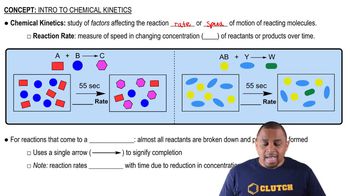Here are the essential concepts you must grasp in order to answer the question correctly.
Order of Reaction
The order of a reaction refers to the power to which the concentration of a reactant is raised in the rate law. It provides insight into how the rate of reaction is affected by the concentration of reactants. Common orders include zero, first, and second, each indicating different relationships between concentration and reaction rate.
Recommended video:
Half-Life of a Reaction
The half-life of a reaction is the time required for the concentration of a reactant to decrease to half of its initial value. For different orders of reactions, the half-life behaves differently; for example, in first-order reactions, the half-life is constant, while in second-order reactions, it increases with decreasing concentration.
Recommended video:
Kinetics and Concentration
In chemical kinetics, the relationship between reaction rate and concentration is crucial. If the half-life of a reaction decreases as the initial concentration increases, it suggests a reaction order greater than one, typically indicating a second-order reaction. This behavior highlights how changes in concentration can significantly influence reaction dynamics.
Recommended video:




